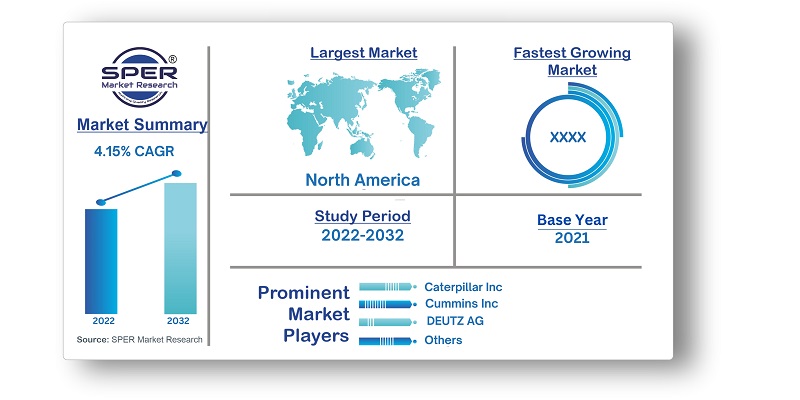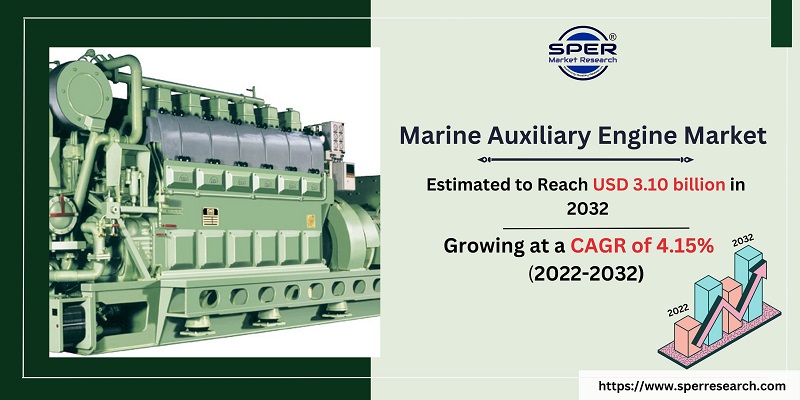
Marine Auxiliary Engine Market Growth, Size, Trends, Challenges and Forecast Analysis 2022-2032
Marine Auxiliary Engine Market Size- By Engine Type, By Ship Type, By Fuel Type, By Stroke, By Power Range, By Application- Regional Outlook, Competitive Strategies and Segment Forecast to 2032
| Published: Mar-2023 | Report ID: MACH2310 | Pages: 1 - 244 | Formats*: |
| Category : Equipment and Machinery | |||


| Report Metric | Details |
| Market size available for years | 2019-2032 |
| Base year considered | 2021 |
| Forecast period | 2022-2032 |
| Segments covered | By Engine Type, By Ship Type, By Fuel Type, By Stroke, By Power Range, By Application. |
| Regions covered | Asia-Pacific, Europe, Middle East and Africa, North America, Latin America |
| Companies Covered | AGCO POWER INC, Caterpillar Inc, Cummins Inc, DEUTZ AG, Hyundai Heavy Industries Co., Ltd, JOHN DEERE, KIRLOSKAR OIL ENGINES LTD, MAN Energy Solutions, Mercury Marine, Mitsubishi Heavy Industries Ltd, Rolls Royce plc, STX ENGINE, Volvo Penta, Yanmar Holdings Co., Ltd |
- Navy (Security Boats)
- Commercial Boats
- Recreational Boats
- Fishing Boats
- Ferries & Transportation Boats
- Others
- Diesel Engine
- Gas Turbine
- Natural Engine
- Propulsion Engine
- Auxiliary Engine
- Other Engine Type
- Bulk Carriers
- Chemical Tankers
- Container Ship
- Ferriers And Passenger Ships
- Gas Carriers
- General Cargo Ships
- Oil Tankers
- Support Vessel
- Others
- Heavy Fuel Oil
- Intermediate Fuel Oil
- LNG
- Marine Diesel Oil
- Marine Gas Oil
- Others
- Four Stroke
- Two Stroke
- Up to 1000Hp
- 1001-5000Hp
- 5001-10000Hp
- 10001-20000Hp
- Above 20000Hp
- Commercial Boats
- Security Boats
- Recreational Boats
- Fishing Boats
- Asia-Pacific
- Europe
- Middle East & Africa
- North America
- Latin America
- Size of Global Marine Auxiliary Engine Market (FY’2019-FY’2032)
- Overview of Global Marine Auxiliary Engine Market
- Segmentation of Global Marine Auxiliary Engine Market By Engine Type (Diesel Engine, Gas Turbine, Natural Engine, Propulsion Engine, Auxiliary Engine, Other Engine Type.)
- Segmentation of Global Marine Auxiliary Engine Market By Ship Type (Bulk Carriers, Chemical Tankers, Container Ship, Ferries And Passenger Ships, Gas Carriers, General Cargo Ships, Oil Tankers, Support Vessel, Others.)
- Segmentation of Global Marine Auxiliary Engine Market By Fuel Type (Heavy Fuel Oil, Intermediate Fuel Oil, LNG, Marine Diesel Oil, Marine Gas Oil, Others.)
- Segmentation of Global Marine Auxiliary Engine Market By Stroke (Four Stroke, Two Stroke.)
- Segmentation of Global Marine Auxiliary Engine Market By Application (Commercial Boats, Security Boats, Recreational Boats, Fishing Boats.)
- Growth Analysis of Global Marine Auxiliary Engine Market
- Problems and Challenges in Global Marine Auxiliary Engine Market
- Competitive Landscape in the Global Marine Auxiliary Engine Market
- Impact of COVID-19 and Demonetization on Global Marine Auxiliary Engine Market
- Details on Recent Investment in Global Marine Auxiliary Engine Market
- Competitive Analysis of Global Marine Auxiliary Engine Market
- Major Players in the Global Marine Auxiliary Engine Market
- Global Marine Auxiliary Engine Market Future Outlook and Projections (FY’2019-FY’2032)
- Recommendations from Analyst
1.1. Scope of the report1.2. Market segment analysis
2.1 Research data source
2.1.1 Secondary data2.1.2 Primary data2.1.3 SPER’s internal database2.1.4 Premium insight from KOL’s2.2 Market size estimation2.2.1 Top-down and Bottom-up approach2.3 Data triangulation
4.1. Driver, Restraint, Opportunity and Challenges analysis4.1.1 Drivers4.1.2 Restraints4.1.3 Opportunities4.1.4 Challenges4.2. COVID-19 Impacts of the Global Marine Auxiliary Engine Market
5.1. SWOT analysis5.1.1 Strengths5.1.2 Weaknesses5.1.3 Opportunities5.1.4 Threats5.2. PESTEL analysis5.2.1 Political landscape5.2.2 Economic landscape5.2.3 Social landscape5.2.4 Technological landscape5.2.5 Environmental landscape5.2.6 Legal landscape5.3. PORTER’S five forces analysis5.3.1 Bargaining power of suppliers5.3.2 Bargaining power of Buyers5.3.3 Threat of Substitute5.3.4 Threat of new entrant5.3.5 Competitive rivalry5.4. Heat map analysis
6.1 Global Marine Auxiliary Engine Market Manufacturing Base Distribution, Sales Area, Product Type6.2 Mergers & Acquisitions, Partnerships, Product Launch, and Collaboration in Global Marine Auxiliary Engine Market
7.1 Diesel Engine7.2 Gas Turbine7.3 Natural Engine7.4 Propulsion Engine7.5 Auxiliary Engine7.6 Other Engine Type
8.1 Bulk Carriers8.2 Chemical Tankers8.3 Container Ship8.4 Ferriers And Passenger Ships8.5 Gas Carriers8.6 General Cargo Ships8.7 Oil Tankers8.8 Support Vessel8.9 Others
9.1 Heavy Fuel Oil9.2 Intermediate Fuel Oil9.3 LNG9.4 Marine Diesel Oil9.5 Marine Gas Oil9.6 Others
10.1 Four Stroke10.2 Two Stroke
11.1 Up to 1000Hp11.2 1001-5000Hp11.3 5001-10000Hp11.4 10001-20000Hp11.5 Above 20000Hp
12.1 Commercial Boats12.2 Security Boats12.3 Recreational Boats12.4 Fishing Boats
13.1 Global Marine Auxiliary Engine Market Size and Market Share by Region (2019-2025)13.2 Global Marine Auxiliary Engine Market Size and Market Share by Region (2026-2032)13.3 Asia-Pacific13.3.1 Australia13.3.2 China13.3.3 India13.3.4 Japan13.3.5 South Korea13.3.6 Rest of Asia-Pacific13.4 Europe13.4.1 France13.4.2 Germany13.4.3 Italy13.4.4 Spain13.4.5 United Kingdom13.4.6 Rest of Europe13.5 Middle East and Africa13.5.1 Kingdom of Saudi Arabia13.5.2 United Arab Emirates13.5.3 Rest of Middle East & Africa13.6 North America13.6.1 Canada13.6.2 Mexico13.6.3 United States13.7 Latin America13.7.1 Argentina13.7.2 Brazil13.7.3 Rest of Latin America
14.1 AGCO Power Inc14.1.1 Company details14.1.2 Financial outlook14.1.3 Product summary14.1.4 Recent developments14.2 Caterpillar Inc.14.2.1 Company details14.2.2 Financial outlook14.2.3 Product summary14.2.4 Recent developments14.3 Cummins Inc14.3.1 Company details14.3.2 Financial outlook14.3.3 Product summary14.3.4 Recent developments14.4 DEUTZ AG14.4.1 Company details14.4.2 Financial outlook14.4.3 Product summary14.4.4 Recent developments14.5 Hyundai Heavy Industries Co.Ltd14.5.1 Company details14.5.2 Financial outlook14.5.3 Product summary14.5.4 Recent developments14.6 John Deere14.6.1 Company details14.6.2 Financial outlook14.6.3 Product summary14.6.4 Recent developments14.7 Kirloskar Oil Engines Ltd14.7.1 Company details14.7.2 Financial outlook14.7.3 Product summary14.7.4 Recent developments14.8 Man Energy Solution14.8.1 Company details14.8.2 Financial outlook14.8.3 Product summary14.8.4 Recent developments14.9 Mercury Marine14.9.1 Company details14.9.2 Financial outlook14.9.3 Product summary14.9.4 Recent developments14.10 Mitsubishi Heavy Industries Ltd14.10.1 Company details14.10.2 Financial outlook14.10.3 Product summary14.10.4 Recent developments14.11 Rolls Royce plc14.11.1 Company details14.11.2 Financial outlook14.11.3 Product summary14.11.4 Recent developments
14.12 STX Engine14.12.1 Company details14.12.2 Financial outlook14.12.3 Product summary14.12.4 Recent developments
14.13 Volvo Penta14.13.1 Company details14.13.2 Financial outlook14.13.3 Product summary14.13.4 Recent developments
14.14 Yanmar Holdings Co.Ltd14.14.1 Company details14.14.2 Financial outlook14.14.3 Product summary14.14.4 Recent developments
SPER Market Research’s methodology uses great emphasis on primary research to ensure that the market intelligence insights are up to date, reliable and accurate. Primary interviews are done with players involved in each phase of a supply chain to analyze the market forecasting. The secondary research method is used to help you fully understand how the future markets and the spending patterns look likes.
The report is based on in-depth qualitative and quantitative analysis of the Product Market. The quantitative analysis involves the application of various projection and sampling techniques. The qualitative analysis involves primary interviews, surveys, and vendor briefings. The data gathered as a result of these processes are validated through experts opinion. Our research methodology entails an ideal mixture of primary and secondary initiatives.



Frequently Asked Questions About This Report
PLACE AN ORDER
Year End Discount
Sample Report
Pre-Purchase Inquiry
NEED CUSTOMIZATION?
Request CustomizationCALL OR EMAIL US
100% Secure Payment






Related Reports
Our Global Clients
Our data-driven insights have influenced the strategy of 200+ reputed companies across the globe.




















